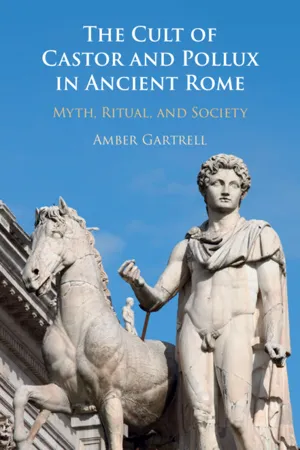
- English
- PDF
- Available on iOS & Android
About this book
The Dioscuri first appeared at the Battle of Lake Regillus in496BC to save the new Republic. Receiving a temple in the Forum in gratitude, the gods continued to play an important role in Roman life for centuries and took on new responsibilities as the needs of the society evolved. Protectors of elite horsemen, boxers and sailors, they also served as guarantors of the Republic's continuation and, eventually, as models for potential future emperors. Over the course of centuries, the cult and its temples underwent many changes. In this book, Amber Gartrell explores the evolution of the cult. Drawing on a range of methodological approaches and a wide range of ancient evidence, she focuses on four key aspects: the gods' two temples in Rome, their epiphanies, their protection of varied groups, and their role as divine parallels for imperial heirs, revealing how religion, politics and society interacted and influenced each other.
Frequently asked questions
- Essential is ideal for learners and professionals who enjoy exploring a wide range of subjects. Access the Essential Library with 800,000+ trusted titles and best-sellers across business, personal growth, and the humanities. Includes unlimited reading time and Standard Read Aloud voice.
- Complete: Perfect for advanced learners and researchers needing full, unrestricted access. Unlock 1.4M+ books across hundreds of subjects, including academic and specialized titles. The Complete Plan also includes advanced features like Premium Read Aloud and Research Assistant.
Please note we cannot support devices running on iOS 13 and Android 7 or earlier. Learn more about using the app.
Information
Table of contents
- Cover
- Half-title page
- Title page
- Copyright page
- Contents
- List of Illustrations
- Translations and Abbreviations
- Acknowledgements
- Introduction
- 1 The Temples of Castor and Pollux
- 2 The Epiphanies of the Dioscuri
- 3 The Responsibilities of Castor and Pollux
- 4 Castor and Pollux as Parallels for Imperial Heirs
- Conclusion
- Bibliography
- Index